Who Really Benefits From Sweatshops?
by David L. Wilson
Consumers are ultimately the ones responsible for dangerous conditions in garment assembly plants in the Global South, Hong Kong-based business executive Bruce Rockowitz told the New York Times recently. The problem is that improved safety would raise the price of clothing, according to Rockowitz, who heads Li & Fung Limited, a sourcing company that hooks up retailers like Macy's and Kohl's with suppliers in low-wage countries like Bangladesh. "So far," he said, "consumers have just not been willing to accept higher costs."
Rockowitz isn't alone in blaming consumers in Europe and the United States for sweatshop conditions in the apparel industry. The idea pervades popular culture. When 1,129 Bangladeshi sweatshop workers died in the Rana Plaza collapse in April, a lawyer in the United Kingdom proposed raising money for the victims by having consumers pay a voluntary "T-shirt tax" on clothing stitched in Bangladesh. "This isn't just the fault of companies who supply cheap clothes," barrister Victoria Butler-Cole explained.
But people rarely ask whether the facts support this idea. How much money do we really save because of cheap labor in the Global South?
Calculating the "T-Shirt Tax"
The quick answer is: nickels and dimes. Although estimates of the percentage of labor costs in clothing's retail price "vary by product and location of production," World Bank senior economist Zahid Hussainwrote in 2010, "it is clear from published academic research that labor costs typically constitute 1-3 percent for a garment produced in the developing world. Hence, large increases in labor costs do not require correspondingly large increases in retail price." The Worker Rights Consortium, a group monitoring sweatshop conditions, came to a similar conclusion in 2005.
Significant wage increases and improvements in conditions at Bangladeshi apparel plants would probably add 40 or 50 cents to the price of a $10 T-shirt, at most. And this is assuming, as Bruce Rockowitz does, that manufacturers and retailers would pass the extra cost on to us.
The assumption might have been valid in the time of Adam Smith. In the eighteenth century there were many small capitalists competing with each other; any savings they made in production, either by cutting wages or adopting new technologies, they would use to reduce prices and undersell their competitors. But as leftist economists Paul Baran and Paul Sweezy showed almost 50 years ago in their book Monopoly Capital, pricing methods are very different now. By the beginning of the twentieth century the most successful companies had succeeded in swallowing up the others, and it didn't make sense for the remaining giant corporations to engage in protracted price wars among themselves. Instead, they started holding prices steady while increasing sales through other means, with an emphasis on marketing.
Companies occasionally revert to the practice of underselling their rivals, and they often take advantage of new technologies to cut prices and generate an increase in sales, as has happened with personal computers since the early 1980s. But there's no automatic connection between lower labor costs and lower prices. The price of a commodity is set by a complicated formula with many different factors, and labor costs are often a minor one.
This is especially true in an industry like apparel, where changing fashions and brand name prestige have a disproportionate effect on pricing; the difference between a $120 pair of Nike sneakers and the $30 shoes at a discount store doesn't come from high wages for workers at Nike's Indonesian suppliers.
Choosing Between Profits and Workers
To get a sense of the relative importance of labor costs, we just need to look at advertising. It's not easy to find exact information on advertising costs, but the staff of the magazine Ad Age made an effort in 2007. They estimated that spending on advertising was equal to 5.1 percent of total sales in the apparel industry, while for apparel stores the number was 4.5 percent. In other words, the cost for advertising the clothes can be as much as five times the cost of stitching them.
Other forms of marketing, such as telemarketing, email marketing, and junk mail, may account for an even larger share of an item's cost. In 2009 writers for Monthly Review calculated that advertising might represent as little as 30 percent of the total cost of marketing.
Suppose we were to cut marketing down to the minimum that consumers really find useful -- information on product availability and prices, for example. The savings would certainly be enough to allow for doubling the wages of many assembly workers and creating safe conditions in their factories, all at no extra cost to consumers.
If we had a say in the matter, it's not likely that we'd choose to let workers die in Bangladesh so that we can have our lives cluttered with ads, junk mail, and celebrity endorsements. After all, the workers, mostly young women and teenage girls, actually stitch our clothes, while the main purpose of advertising is just to get us to buy more products from one company than from another, or to create an artificial demand so that we'll buy more than we need.
But the sweatshop system isn't about what consumers want, and it's certainly not about what the workers want; the goal is to increase profits for manufacturers and retailers, to make the superrich even richer.
While blaming consumers for sweatshop conditions, Li & Fung CEO Bruce Rockowitz has done quite well from the business of sourcing sweatshops for multinationals. His company had some $20 billion in revenues in 2012, and owners Victor and William Fung are each worth about $3 billion. Businessweek estimates that Rockowitz's personal compensation last year was $6.955 million, and his net assets have been put at $33 million or more. In October 2011 Rockowitz married Hong Kong pop star Coco Lee in a ceremony that reportedly cost $20 million.
David L. Wilson is co-author, with Jane Guskin, of The Politics of Immigration: Questions and Answers, Monthly Review Press, July 2007. He also co-edits Weekly News Update on the Americas, a summary of news from Latin America and the Caribbean.
原文網址:http://mrzine.monthlyreview.org/2013/wilson120913.html
原文網址:http://www.coolloud.org.tw/node/75697
2013/09/24
公共論壇
蕭函青
輔仁大學心理學系碩士班學生、高科技冷血青年成員
責任主編:王顥中
大埔張家悲劇帶來的哀痛和怒火仍激盪在我們心中,同一時間,國內搖滾天團五月天的〈入陣曲〉新MV[1]在社運圈引起了不小的議論。許多人認為,他們用隱晦的歌詞搭配社運抗爭的新聞,包裝反抗意識,在主流樂團中已值得肯定。
事實上,這已經不是五月天第一次為社會正義發聲了,今年(2013)年初,反核聲浪四起之際,五月天的團員也在各種場合表達反核立場,一瞬間,他們從陪伴我們青春的熱血勵志樂團,昇華成社會正義發聲的良心。
原文網址:http://www.coolloud.org.tw/node/75108
2013/07/28 苦勞報導 孫窮理 苦勞網記者
責任主編:陳韋綸
以罐裝「伯朗咖啡」及咖啡店聞名的金車企業,傳出旗下「金車物流」司機工時過長,導致疲勞駕駛,以及管理階層利用調度車趟權力打壓工會的消息。今天(7/28)金車物流公會與青年勞動九五聯盟等聲援團體,前往伯朗咖啡館台科大店抗議,並將紅色染料塗抹在玻璃窗上,以「血汗咖啡」諷刺在台灣企業形象良好的金車產品,並要求據聞在同一棟大樓內的管理階層出面對話;不過經過約1個小時,資方並未出面,工會則揚言發起下一波行動。
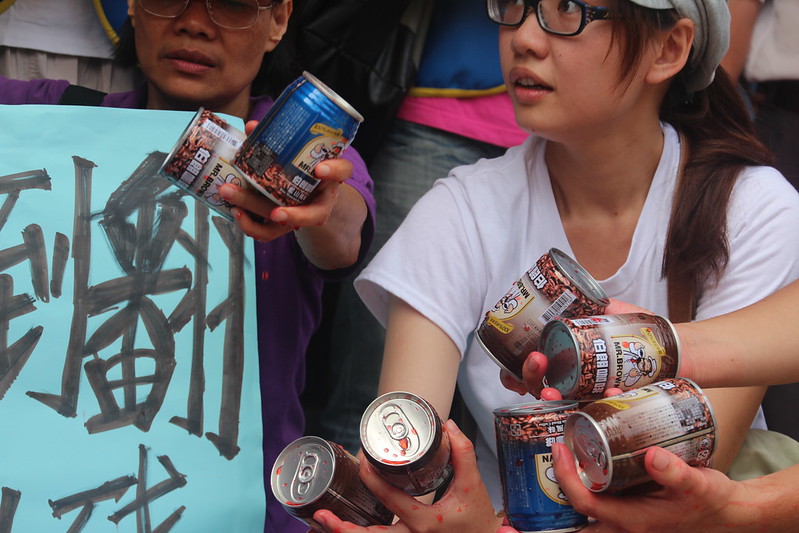 工會與聲援者以塑膠桶把「伯朗咖啡」浸泡在紅色顏料裡,指控金車物流剝削司機,賣的是「血咖啡」。(攝影:孫窮理)
工會與聲援者以塑膠桶把「伯朗咖啡」浸泡在紅色顏料裡,指控金車物流剝削司機,賣的是「血咖啡」。(攝影:孫窮理) 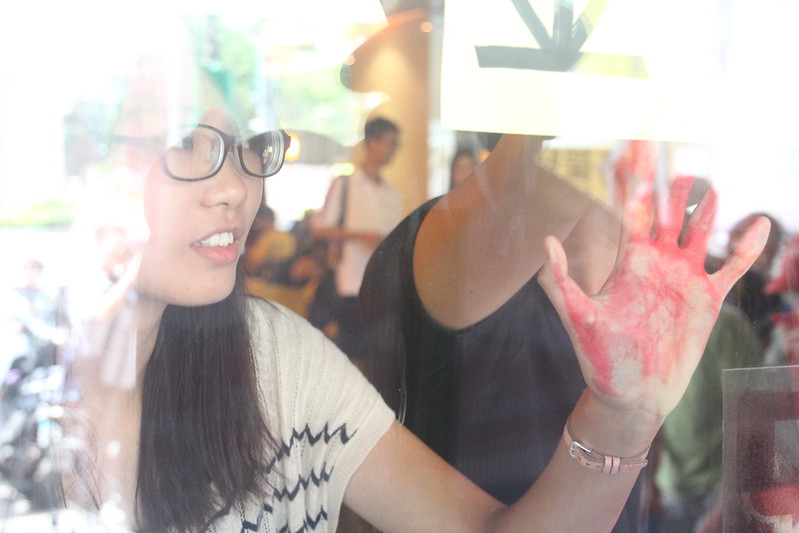 事先進入店內的抗議者把雙手塗紅,在窗戶上印出「血手印」。(攝影:孫窮理)
事先進入店內的抗議者把雙手塗紅,在窗戶上印出「血手印」。(攝影:孫窮理)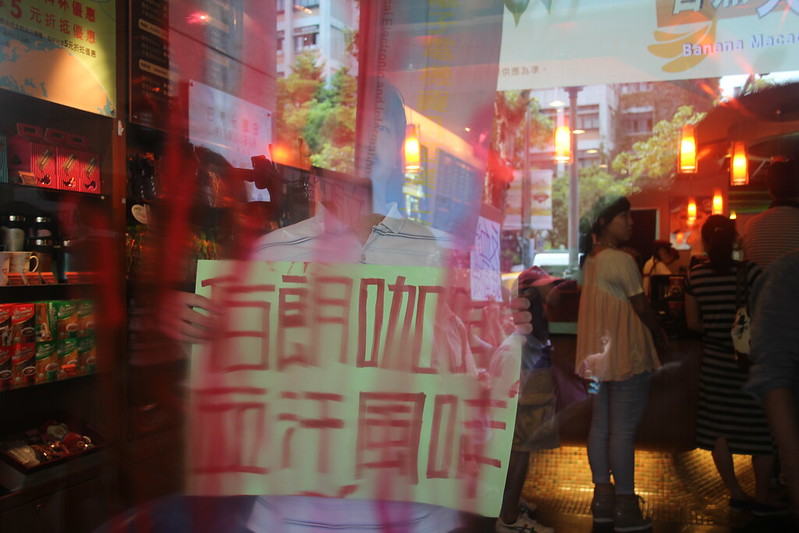 「伯朗咖啡,血汗風味」。(攝影:孫窮理)
「伯朗咖啡,血汗風味」。(攝影:孫窮理) 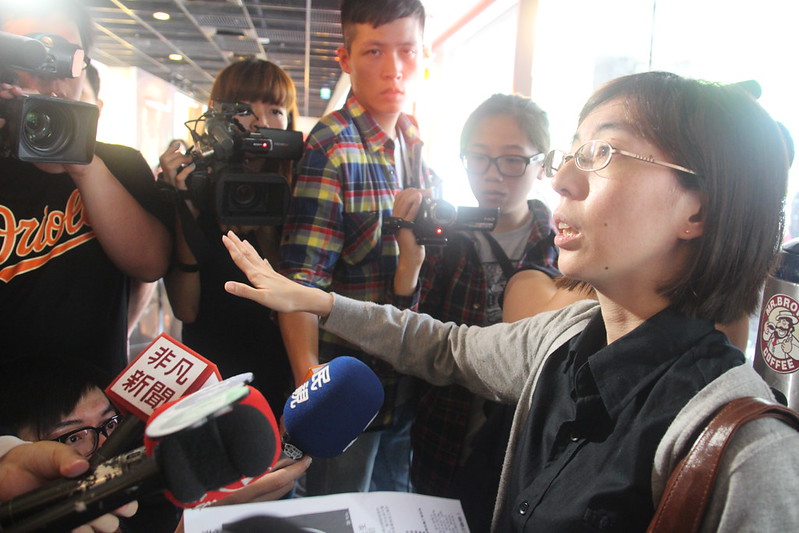 資方高層完全不出面回應,伯朗咖啡北科大店的幹部完全不知道發生什麼事,被媒體追到角落,無法回應。(攝影:孫窮理)
資方高層完全不出面回應,伯朗咖啡北科大店的幹部完全不知道發生什麼事,被媒體追到角落,無法回應。(攝影:孫窮理) 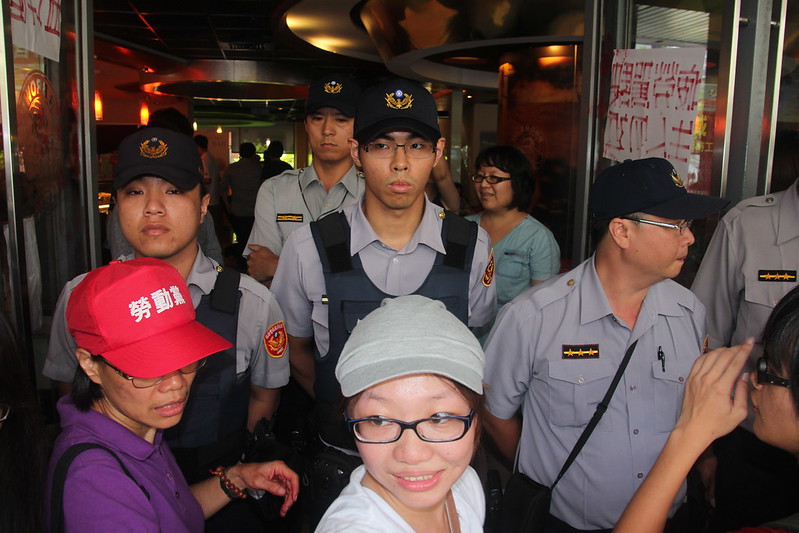
為阻止抗議者進入店內,警方一度舉牌警告,並組成人牆堵住店門口,使咖啡館無法進出。(攝影:孫窮理)
因為「椎間盤凸起」,身上仍帶著治療用護具、金車物流工會監事柯恢悟才剛開過刀,目前因職業病留職停薪,為了今天的抗爭,特別吃了加重份量的止痛藥才能久站。「椎間盤凸起」是司機駕駛長期工作後,經常發生的職業病;柯恢悟表示,長期以來,金車物流司機每日工時長達12小時、甚至長達16、17個小時,甚至發生24小時都在工作的狀態。工時過長的現象經過檢舉,桃園縣勞動及人力資源局也對金車開罰,不過公司高層親口對工會說「金車有的是錢,不怕它罰」;而在職災的責任上,柯恢悟表示自己的職業病已經經過鑑定確認,但是資方至今不願意負起職災責任,只同意先給予半年「留職停薪」。
金車物流運送的主要物品是包括伯朗咖啡、波爾茶這些商品,目前公司旗下有30多部連結車;5、6年前司機組織工會,按《工會法》30人才能組織工會的規定,當時差不多所有司機都加入工會。柯恢悟說,現在這個主管,去年(2012)5月上任後,要求司機不可加入工會,參加工會的人,就會排給他「比較累、比較不容易賺的車趟」。
公司計薪方式,與一般客貨運業類似,底薪只有1萬2千塊,之後用「獎金」之類的名目往上面加;而「車趟獎金」是以車趟計,換句話說,花較長時間才能完成的車趟,司機一天能跑的車趟減少,「車趟獎金」也就跟著減少;在這樣的操作下,參與工會的成員每月收入比起配合主管要求的人,少了2、3萬左右;在這種情形下,參與工會的人越來越少,現在只剩下幾個幹部。
工會提出「合理分配車趟」、「停止打壓工會」、「防止過勞駕駛」等訴求。目前工會成員認為,打壓動作主要是出自「主管的意志」,金車集團的董事長李添財只是「授權幹部」,讓他這樣做;不過經過今天抗議行動,公司方面並沒有任何人出面,也沒有任何回應。工會與聲援團體表示,金車若不正面回應,或者繼續打壓工會,將發起下一波行動。



